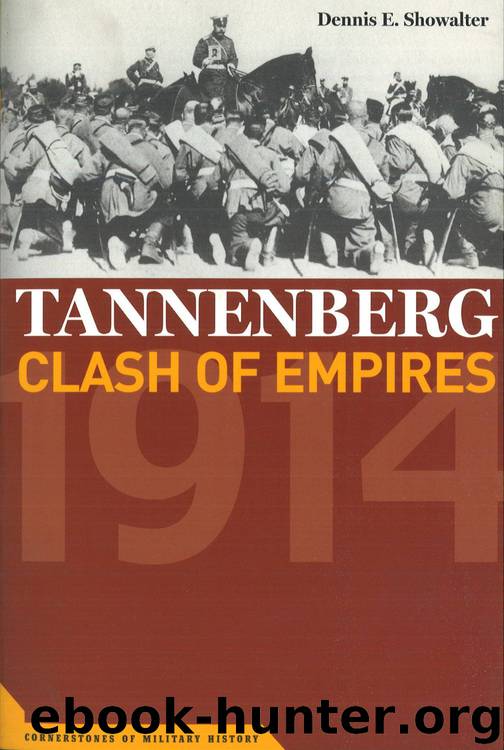Tannenberg: Clash of Empires, 1914 by Dennis E. Showalter

Author:Dennis E. Showalter [Showalter, Dennis E.]
Language: eng
Format: epub
ISBN: 9781574887815
Amazon: 1574887815
Publisher: Potomac Books Inc.
Published: 2016-01-04T16:00:00+00:00
PART III
THE BLOOD-SWOLLEN GOD
7
The Province of Uncertainty
I
On a map, the advance of the Russian 2nd Army was a deadly thrust. An attack northwest towards the Vistula, if successful, would render impossible any German plans for switching troops from sector to sector behind the line of the Masurian Lakes. It would cut the German lines of communication into East Prussia. It would hopelessly trap every German soldier in the province. Ostheer would be forced either to fight at a disadvantage or to let itself be shut up in Königsberg. This bold conception was the product of evolution. Zhilinski, initially mindful of the risks of dividing his forces, had originally planned only a tactical envelopment on the 2nd Army’s front, with two of its corps advancing directly west towards the line Lyck-Johannesburg, and two more executing a short left hook around the Masurian Lakes. Then on August 10 the Russian high command “suggested” instead that the major axis of the 2nd Army’s advance should be south of the Lakes. Zhilinski took the recommendation as an order. On August 13 he informed Samsonov that the 2nd Army was to shift its lines of march westward. From right to left, VI, XIII, and XV Corps, and a division of XXIII Corps would advance to the line Rudczanny-Passenheim, then swing north to Seeburg-Rastenburg. Only II Corps would advance directly against the Masurian Lakes, while maintaining contact between the 1st and 2nd Armies. To cover his left, which would be more exposed by this change in plans, Samsonov was assigned three more divisions, I Corps, the 3rd Guard Division, which was the other division of XXIII Corps.
Samsonov himself made a third set of changes in his march orders. His Directive Number 1, issued on August 16, extended the front of his advance by a further twenty-five miles. On paper the objective remained that set by Zhilinski: the line Rudczanny-Passenheim. But the 2nd Army’s three center corps would now begin by marching northwest. Only after crossing the frontier would they begin swinging northward as originally instructed.
When Zhilinski protested sharply, Samsonov answered that the new lines of advance were necessary if he was to have sufficient freedom to maneuver. His alteration offered the chance of enveloping the Germans, avoiding the costs and risks of a head-on encounter. It also required two days’ extra marching for the corps involved. It increased the risk of losing communication with the 1st Army. It set back the time when the Russian forces could unite. It created the possibility of a dangerous overextension of the 2nd Army’s front. And it demanded from the start extremely rapid movements.1
Complaints from higher authorities received the unvarnished reply that the troops were moving as fast as they could but were being delayed by “sand.” More than sand was involved. To reach Samsonov’s revised line of departure from their original concentration areas, XV, XIII, and VI Corps had to average between sixteen and eighteen miles a day for five days. Even more than on Rennenkampf’s front the strategic
Download
This site does not store any files on its server. We only index and link to content provided by other sites. Please contact the content providers to delete copyright contents if any and email us, we'll remove relevant links or contents immediately.
The Radium Girls by Kate Moore(11616)
100 Deadly Skills by Clint Emerson(4686)
The Templars by Dan Jones(4556)
Rise and Kill First by Ronen Bergman(4542)
The Doomsday Machine by Daniel Ellsberg(4241)
The Rape of Nanking by Iris Chang(4020)
Killing England by Bill O'Reilly(3896)
Hitler in Los Angeles by Steven J. Ross(3796)
Stalin by Stephen Kotkin(3722)
12 Strong by Doug Stanton(3418)
Hitler's Monsters by Eric Kurlander(3161)
Blood and Sand by Alex Von Tunzelmann(3055)
Darkest Hour by Anthony McCarten(3017)
The Code Book by Simon Singh(2855)
The Art of War Visualized by Jessica Hagy(2836)
Hitler's Flying Saucers: A Guide to German Flying Discs of the Second World War by Stevens Henry(2621)
Babylon's Ark by Lawrence Anthony(2427)
The Second World Wars by Victor Davis Hanson(2419)
Tobruk by Peter Fitzsimons(2373)
